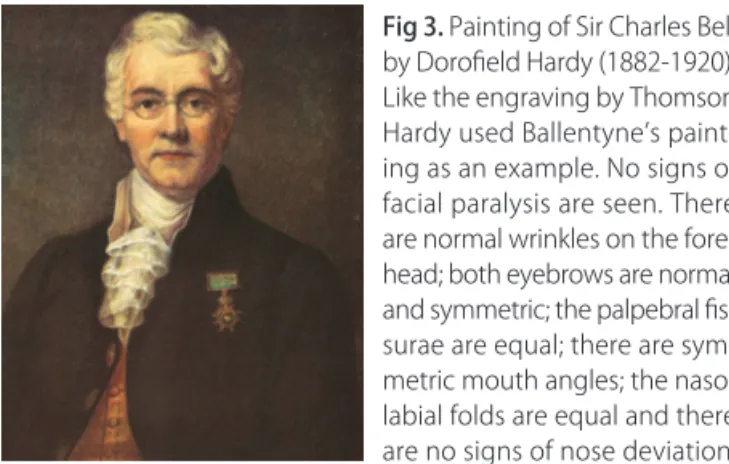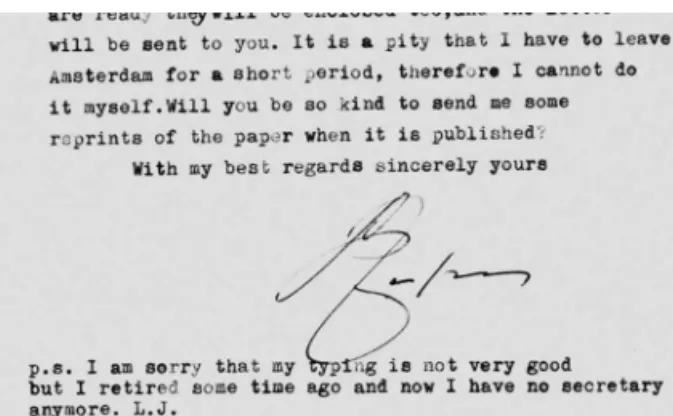321
Arq Neuropsiquiatr 2010;68(2):321-324
Opinion
Sir Charles Bell was not afected by facial paralysis himself !
Despite our recent commentary on the article by Re-sende and Weber1, the authors still seem to believe that Sir Charles Bell (1774-1842) himself was afected by facial paralysis2. hey came to this erroneous conclusion from a paper by Jongkees3 and by “neurological examination of the photograph of Sir Charles Bell” (Fig 1).
However, had they taken the efort to check Jongkees’ German translation with the original English text in Bell’s publication4 the authors would most probably have come to our conclusion that this case report had nothing to do with the clinical history of Sir Charles Bell himself, but that it was a self-observation by Roux of Paris, who in-deed did sufer facial paralysis (Fig 2).
To our knowledge there is no original photograph of Bell available. What the authors believe to be a photo-graph of Bell is in fact an engraving made by J. hompson (probably James hompson (1788-1850)). he engrav-ing was published in homas Joseph Pettigrew’s (1791-1865) ‘Biographical memoirs of the most celebrated phy-sicians, surgeons, etc. etc.’5, and is part of a biography of Charles Bell, in which no evidence can be found of Bell having had facial paralysis. hompson had made this en-graving after a painting of Bell by John Ballentyne (1815-1897), which makes it an even less objective depiction of Sir Charles Bell. his is clearly illustrated by diferences between hompson’s engraving and the painting of Bell by Doroield Hardy (1882-1920) (Fig 3), who also used Ballentyne’s painting as an example6.
In general an artwork is less accurate than a photo-graph as it is more subject to the personal interpreta-tions, preferences and choices of the artist. Moreover, one has to be careful to conclude that a piece of art such as an engraving, depicts facial paralysis, as it is static in the facial expression and the course of the paralysis. Study-ing hompson’s engravStudy-ing and Hardy’s paintStudy-ing with the same ‘biased’ attitude as the authors do, we can state that there is no nasal deviation and a perfectly normal nasola-bial fold, which plead against a facial paralysis.
herefore, we think that the authors must provide oth-er and bettoth-er evidence if they still believe that Sir Charles Bell had facial paralysis himself. Otherwise, we hope that this historical error has now been rectiied.
RefeRences
1. Korteweg SFS, Van de Graaf RC, Werker PMN. About the right facial palsy of Charles Bell. Was Sir Charles Bell himself really afected by facial paralysis?
Fig 1. Engraving of Sir Charles Bell, made by J. Thompson (probably James Thompson (1788-1850), on which the au-tors based their diagnosis of right facial paralysis.
Fig 3. Painting of Sir Charles Bell by Doroield Hardy (1882-1920). Like the engraving by Thomson Hardy used Ballentyne’s paint-ing as an example. No signs of facial paralysis are seen. There are normal wrinkles on the fore-head; both eyebrows are normal and symmetric; the palpebral is-surae are equal; there are sym-metric mouth angles; the naso-labial folds are equal and there are no signs of nose deviation.
Fig 2. A copy from Bell’s original work in which is clearly stated that the case of paralysis of the face concerns Roux of Paris.
Opinion
Comment on “Peripheral facial palsy in the past: contributions from Avicen-na, Nicolaus Friedreich and Charles Bell”. Arq Neuropsiquiatr 2009;67:783. 2. Resende LAL, Weber SAT. The authors’ reply on “About the right facial palsy
of Charles Bell”. Arq Neuropsiquiatr 2009;67:783-784.
3. Jongkees LBW. Bemerkungen zur Geschichte der Fazialischirurgie. HNO 1979;27:325-333.
Arq Neuropsiquiatr 2010;68(2)
322
Opinion
5. Pettigrew TJ. Biographical memoirs of the most celebrated physicians, sur-geons, etc. etc. London: Whittaker and Co., Ave-Maria Lane 1839. 6. Gordon Taylor G, Wall EW. Sir Charles Bell, his life and times. Edinburgh and
London: E&S Livingstone Ltd, 1958.
Korteweg SFS, MD Van de Graaf RC, MD Werker PMN, MD, PhD
Department of Plastic Surgery,
University Medical Center Groningen, The Netherlands P.O. Box 30.001 - NL-9700 RB Groningen
E-mail: s.f.s.korteweg@plchir.umcg.nl
The AuThoRs’ Repply
he Netherlands are really a country of contrasts. he South is predominantly industrialized, in the North pre-dominates agriculture. he South is catholic, the North Calvinist. he South is more populous, the North less. here is carnival at the South, but not at the North. In the South live more immigrants, in the North less. In Amster-dam, Dutch language is predominant, in the North dia-lects are more common. Professor L.B.W. Jongkees lived and worked in Amsterdam, and is dead. Korteweg lives and works in Gröningen, and probably is young. Profes-sor Jongkees worked on and studied the interior of the cranium, as an otolaryngologist; Korteweg works on the exterior of the cranium, as a plastic surgeon. Professor Jongkees published over 400 papers1, and was Editor-in-Chief of the Dutch Journal of Medicine (1971-1982) (Fig 1). Korteweg has 1 (one) published paper, in this period-ic, where he airms that Jongkees “introduced an error”: the right facial paralysis of Charles Bell.
By Professor Jongkees, by all professors of the world, and in the internet, Sir Charles Bell is presented on a black-and-white good quality portrait. his portrait was shown in our published paper about the history of facial palsy2. Korteweg showed an almost unknown colored bad quality image.
Professor Jongkees was probably modest and simple, as
we can see in the letter to the irst author (Resende LAL), written in 1983, when Resende was a simple and unknown Medical Resident of South America (Fig 2). Professor Jon-kees wrote “… I am sorry that my typing is not very good but I retired some time ago and now I have no secretary anymore”. Based on this analysis, we may conclude that we are in front of a new Dutch baroque problem: Korteweg versus Professor Jongkees. To solve this new Dutch roque problem, we suggest the help of an old Dutch ba-roque Professor: Rembrandt Harmenszoon van Rijn (Fig 3). In this self-portrait of 1629-16303, Rembrandt probably had a “clinical problem” on his right face. Can Korteweg et al. solve this enigma? What may be the diagnosis? We think that this solution would help them to solve the co-nundrum of the clinical problem presented in the right hand side face of Sir Charles Bell portrait (we carefully se-lected one Rembrandt’s painting with right hand face prob-lem to facilitate the clinical exercise of Korteweg et al.). If necessary, they may access another paper where Ti-zian and Tintoretto presented people with similar “enig-matic” clinical problems on the right hand side face (Re-sende LAL et al., 2010). We carefully selected only right hand face presentations to facilitate the clinical exercise of Korteweg et al.
RefeRences
1. Van’t Hof SE. Leonard Barend Willem Jongkees, editor-in-chief of the Dutch Journal of Medicine (1971-1982). Ned Tijdschr Geneeskd. 2007;151: 2913-2915.
2. Resende LA, Weber SAT. Peripheral facial palsy in history: the contribu-Resende LA, Weber SAT. Peripheral facial palsy in history: the contribu-Peripheral facial palsy in history: the contribu-tions of Avicenna, Nicolaus Friedreich and Charles Bell. Arq Neuropsiquia-tr 2008;66:765-769.
3. Mannering D. A arte de Rembrandt. Rio de Janeiro: Livro Técnico, 1981 31.
Resende LAL* Weber SAT*
Services of Neurology* and Othology* Botucatu School of Medicine 18618-000 Botucatu SP - Brasil E-mail: luanlire@hotmail.com
Fig 2. Part of the letter from Yongkees sent to the irst author (Resende LA) in 1983.
Fig 1. Professor Leonard Barend Willem Jongkees (1912-2002), editor-in-chief of the Dutch Jour-nal of Medicine (1971-1982).

